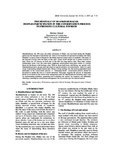The heritage of Shankharibazar: peoples participation in the conservation process to promote cultural tourism
Abstract
Shankharibazar, the 300 years old urban settlement of Dhaka city was built during the Mughal period and the later part of the British rule. Most of the residents are specialist craftsmen who make 'Shankha' (a special kind of bangle for the Hindu married women made of seashells). The name of the area has evolved from the name of this craft. About 10,000 people live in about 4.6 acres of land. There are 157 houses on both side of the 600 feet long narrow alley. They share unique architectural styles. Over the years many unplanned modifications took place which is a serious threat for the houses with heritage value. With its linear built form, rich history and special craft, Shankharibazar has a unique aura and deserved special attention for conservation. There is a good scope of promoting cultural tourism here. Being a living heritage site, the existing population must participate in the conservation process. A "community-based" conservation process should be promoted to market the area as a tourist attraction. This paper suggests the process of integrated public involvement in the conservation management plan for Shankharibazar including steps, such as, understanding problems; generating and evaluating the options for response; and ultimately choosing a roadmap for conservation management for a successful spot for cultural tourism.

